
Top Banaras Places to Visit – Culture, Temples & More 2025
Banaras Places: A Journey Through the Spiritual Heart of India
Nestled along the sacred banks of the Ganges River, Banaras – also known as Varanasi or Kashi – stands as one of the world’s oldest continuously inhabited cities. This ancient metropolis holds profound religious significance in Hinduism, deeply intertwined with Lord Shiva’s divine presence.
According to Hindu mythology, Lord Shiva himself founded this holy city. A testament to this belief lies in the ancient tale of Brahma’s dishonored head falling at this sacred spot. Banaras Places holds the distinction of being one of the Sapta Puri – seven holy cities believed to grant moksha (liberation) to devotees.
The city’s spiritual landscape features numerous remarkable destinations:
- Kashi Vishwanath Temple – A revered shrine dedicated to Lord Shiva
- Dashashwamedh Ghat – Home to the mesmerizing daily Ganga Aarti
- Manikarnika Ghat – The sacred cremation grounds
- Sarnath – Buddha’s first sermon site
- Ancient Temples – Including Sankat Mochan and the Nepali Temple
- Cultural Landmarks – Ramnagar Fort and Bharat Kala Bhavan Museum
The city’s 88 ghats serve as spiritual staircases to the holy Ganges, where pilgrims perform sacred rituals and ceremonies. These stone steps have witnessed centuries of devotion, making Banaras Places a living testament to India’s rich spiritual heritage.
Table of Contents
1. Kashi Vishwanath Temple
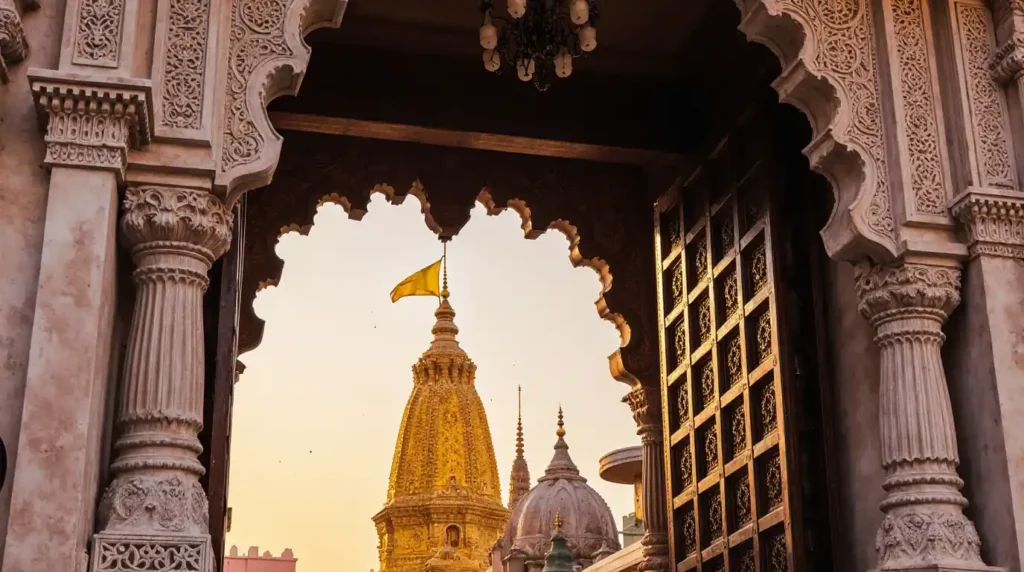
The Kashi Vishwanath Temple is a symbol of India’s spiritual heritage, dedicated to Lord Shiva, the supreme deity of destruction and transformation. It is located in the heart of Varanasi and attracts millions of devotees who come to seek blessings from the divine Jyotirlinga – one of the twelve most sacred Shiva temples in India.
A Rich History
The temple’s history goes back centuries, with the current structure built in 1780 by Maharani Ahilyabai Holkar of Indore. The original temple faced multiple destructions during various invasions but its spiritual significance remained intact.
Architectural Marvel
The temple’s architecture is a sight to behold, with:
- Three distinctive domes plated with pure gold
- Intricate stone carvings depicting Hindu mythology
- Sacred Nandi shrine facing the main sanctum
- Traditional Nagara style of North Indian temple architecture
- Ornate silver doorways leading to inner chambers
Sacred Features
Inside the temple complex, you will find several significant elements:
- The main Jyotirlinga, believed to be self-manifested
- Sacred well known as Jnana Vapi (wisdom well)
- Shrines dedicated to other Hindu deities
- Ancient Sanskrit inscriptions on temple walls
- Traditional mandapa (pillared hall) for meditation
Recent Renovation
The recent Kashi Vishwanath Corridor project has transformed the temple surroundings, creating a spacious complex spanning 5,000 square meters. This renovation has preserved the temple’s ancient essence while providing modern amenities for pilgrims.
Rituals and Timings
Devotees perform specific rituals including:
- Early morning abhishek (sacred bath) of the Jyotirlinga
- Offering of bilva leaves and milk
- Chanting of Vedic mantras
- Evening aarti ceremonies with traditional musical instruments
- Meditation in the temple premises
The temple remains open from 2:30 AM to 11:00 PM, with special arrangements during festivals like Maha Shivaratri and Shravan.
2. Dashashwamedh Ghat
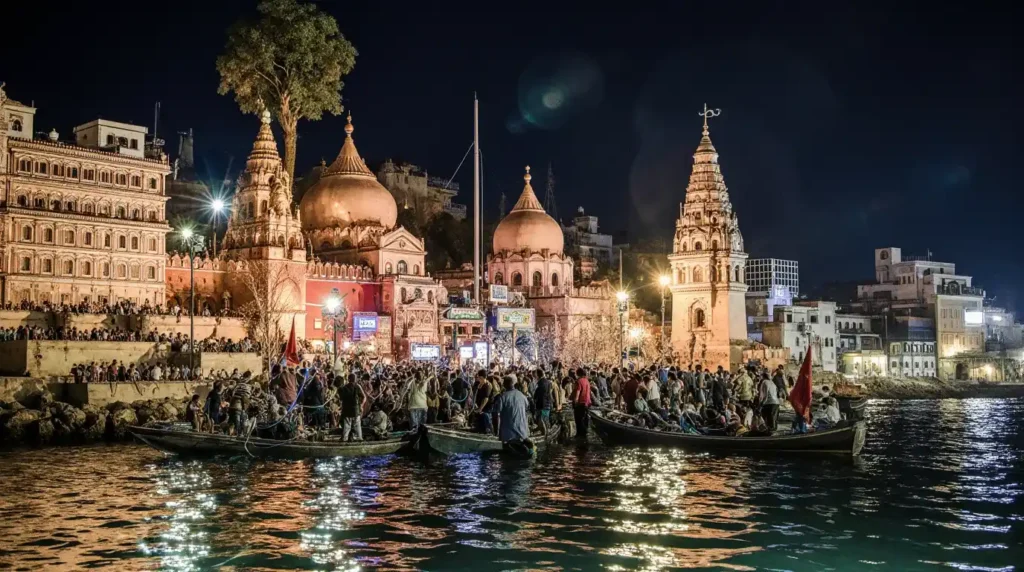
Located in the center of Varanasi’s spiritual area, Dashashwamedh Ghat is a symbol of ancient Hindu stories and ongoing customs. According to legend, Lord Brahma performed ten horse sacrifices (dash ashwamedh) at this holy place, filling it with divine energy.
The Daily Rhythm of Dashashwamedh Ghat
The ghat is alive with spiritual activities from morning till night:
- Morning Rituals: At sunrise, pilgrims come down the steps for sacred baths while priests conduct puja ceremonies.
- Daytime Activities: Holy men meditate in stone alcoves as devotees seek blessings.
- Cultural Hub: Musicians and artists gather to practice classical arts.
- Sacred Offerings: Devotees float diyas (oil lamps) and flower offerings in the Ganges.
The Evening Spectacle: Ganga Aarti
The highlight of Dashashwamedh Ghat happens every evening during the mesmerizing Ganga Aarti. This ancient ceremony brings together:
- Seven priests moving in perfect harmony
- Multi-tiered brass lamps weighing several kilograms
- Sacred chants resonating across the river
- Clouds of incense creating an enchanting atmosphere
- Hundreds of small diyas lighting up the steps
The ceremony kicks off exactly at sunset, turning the ghat into a grand stage for divine worship. Priests perform intricate movements with flaming lamps, incense, and peacock fans, crafting a captivating dance of light and shadow against the darkening sky.
Architectural Splendor of Dashashwamedh Ghat
The ghat’s architectural beauty includes:
- Wide stone steps leading down to the river
- Ancient shrines and temples lining the edges
- Traditional parasols and platforms for ceremonies
- Stone-carved pillars marking ritual spaces
A Unique Perspective: Boat Rides During Aarti
Boat rides during the aarti offer a one-of-a-kind viewpoint, allowing visitors to experience the ceremony while drifting on the sacred waters of the Ganges. The reflection of countless lamps on the river’s surface creates a magical mirror effect, enhancing the grandeur of the spectacle.
3. Assi Ghat
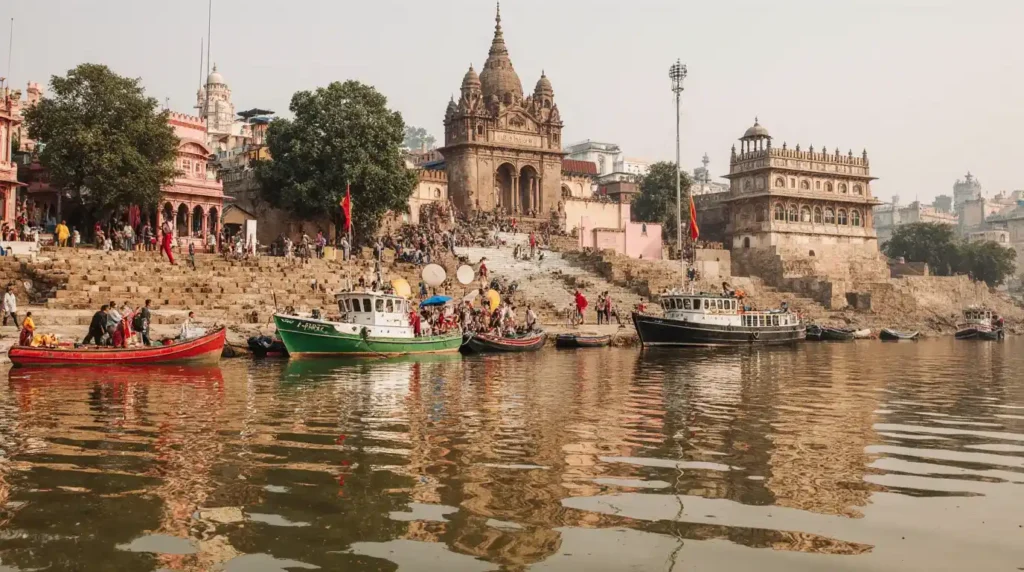
Assi Ghat is the southernmost ghat in Varanasi, where the Assi and Ganges rivers meet. This lively cultural center is full of energy from sunrise to sunset, attracting both spiritual seekers and culture lovers.
Morning Yoga Sessions
Every morning, yoga enthusiasts gather at the ghat for outdoor sessions with the rising sun as their backdrop. The ancient stone steps become an impromptu yoga studio, creating a peaceful atmosphere for meditation and spiritual practice.
Year-Round Cultural Events
Throughout the year, Assi Ghat hosts various cultural events that showcase the rich traditions of the region:
- Classical Music Performances: Local musicians perform traditional Benares gharana music
- Poetry Recitations: Established and emerging poets come together for kavi sammelans
- Art Exhibitions: Local artists display their works along the riverfront
- Traditional Dance Shows: Classical dance performances celebrate Indian cultural heritage
Tempting Banaras Places Street Food
As you explore the area around Assi Ghat, don’t miss out on trying these authentic Banaras Places street food delicacies:
- Tamatar chaat: A tangy tomato snack
- Banaras Places paan: A betel leaf preparation
- Lassi: A refreshing yogurt drink
- Malaiyo: A winter specialty dessert
Cultural Gatherings and Rituals
The spacious platform of Assi Ghat serves as a natural amphitheater for various cultural gatherings. Students from nearby universities often organize programs here, while local priests carry out daily rituals at the Assi Ghat temple.
Festivals at Assi Ghat
During festivals like Dev Deepavali, Assi Ghat becomes a magical place with thousands of earthen lamps lighting up its steps. This combination of spirituality and cultural vibrancy makes Assi Ghat a must-visit destination to experience the true essence of Banaras Places.
4. Manikarnika Ghat
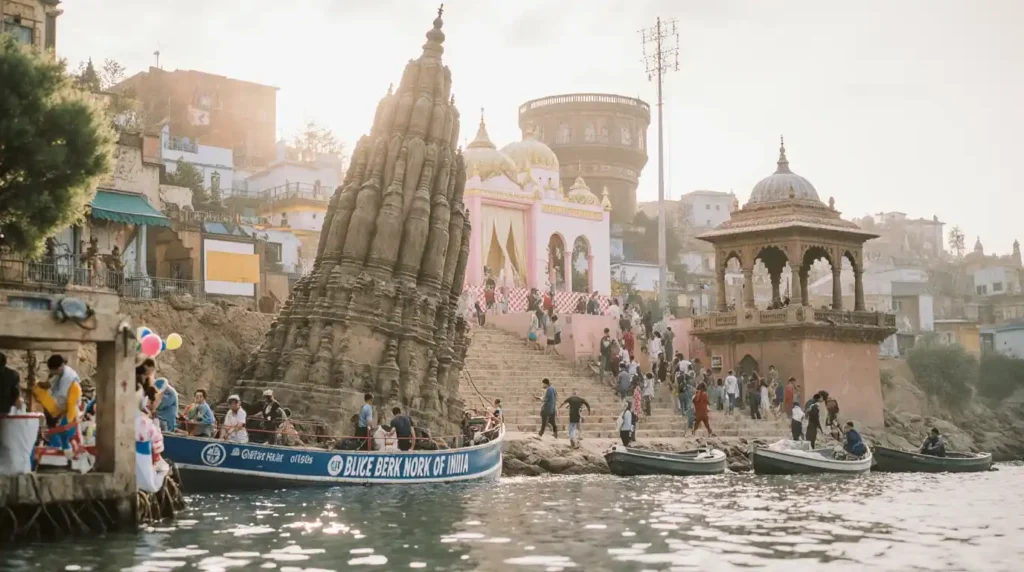
Manikarnika Ghat is one of the most sacred cremation grounds in Varanasi and holds great spiritual importance in Hindu traditions. According to ancient texts, Lord Shiva whispered the Taraka mantra (liberation chant) in the ears of the deceased at this sacred spot, granting instant moksha to those cremated here.
The Meaning Behind the Name
The ghat gets its name from two significant elements:
- Manikarnika: The jeweled earring of Lord Shiva
- Kund: A sacred well believed to have been dug by Lord Vishnu
The Cremation Rituals at Manikarnika Ghat
The cremation rituals at Manikarnika Ghat follow precise spiritual protocols:
- Preparation: The body is wrapped in specific cloths and carried through narrow lanes
- Purification: Immersion in the Ganges waters
- Sacred Fire: Obtained from the eternal flame maintained by the Dom Raja
- Final Rites: Performed by family members under guidance of priests
The Role of the Dom Community
The Dom community, led by their hereditary king (Dom Raja), maintains the eternal fire used to light every funeral pyre. This fire, believed to burn for centuries, holds immense religious significance.
The Architectural Landscape
The architectural landscape features stone platforms rising from the riverbank, ancient shrines, and traditional buildings. Wooden pyres burn continuously as part of the cycle of life and death, while priests and mourners perform ancient rituals passed down through generations.
Beliefs About Death in Kashi
Hindu devotees believe that death in Kashi and cremation at Manikarnika Ghat breaks the cycle of rebirth, leading to direct liberation. This belief draws countless elderly people to spend their final days in the holy city, awaiting their ultimate journey.
5. New Vishwanath Temple at BHU

The New Vishwanath Temple is an impressive architectural masterpiece located within the expansive campus of Banaras Hindu University. Constructed in 1966, this white marble temple beautifully combines traditional temple architecture with modern engineering principles.
Design and Features
The temple’s design draws inspiration from the original Kashi Vishwanath Temple and includes several notable features:
- A towering main spire that reaches a height of 77 meters
- Intricate marble carvings depicting various Hindu deities
- Seven temples dedicated to different gods, all built on a single platform
- A spacious prayer hall capable of accommodating thousands of devotees
Inscriptions and Patterns
The walls of the temple are adorned with detailed inscriptions from Hindu scriptures, including verses from the Bhagavad Gita and Upanishads. Additionally, the marble floors boast geometric patterns that create mesmerizing optical illusions when viewed from different angles.
Temple Complex
In addition to the main temple structure, the complex also houses several other facilities:
- A dedicated meditation hall for quiet contemplation
- A museum that showcases religious artifacts
- Landscaped gardens featuring serene fountains
- An ancient manuscripts library for scholarly pursuits
Inclusivity and Education
Unlike its ancient counterpart, the New Vishwanath Temple embraces visitors from all faiths and backgrounds. It serves not only as a spiritual center but also as an educational institution, hosting regular lectures on Hindu philosophy and Sanskrit studies.
Blend of Spiritual and Academic Atmospheres
The strategic location of this temple within the BHU campus creates a unique blend of spiritual and academic atmospheres. Here, students often gather between classes to find moments of quiet reflection amidst their busy schedules.
6. Sankat Mochan Hanuman Temple
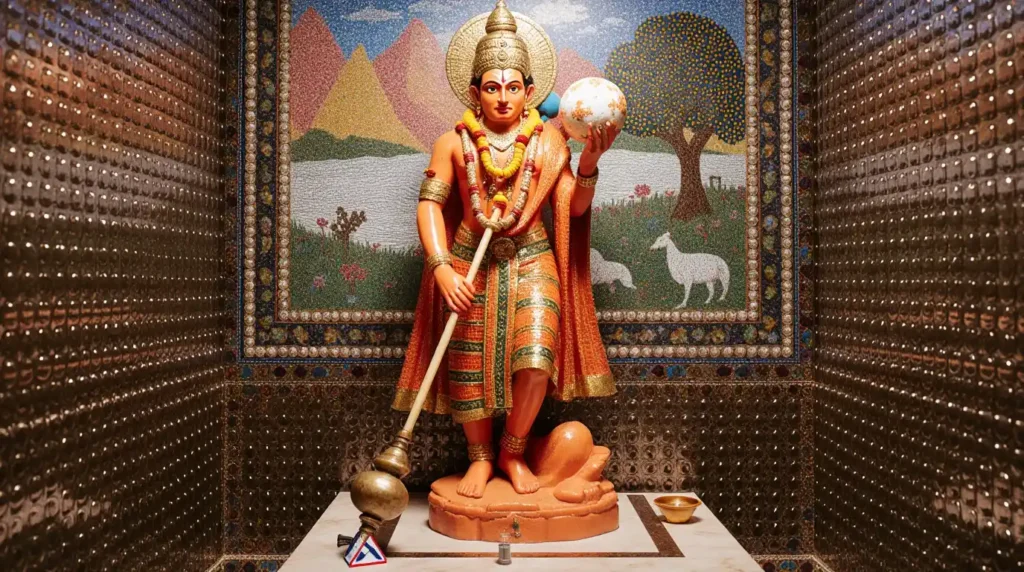
The Sankat Mochan Hanuman Temple is a place of worship in Banaras Places, attracting many followers who come to seek blessings from Lord Hanuman, known as the remover of obstacles. Constructed in the early 1900s, this temple holds great importance as it is associated with both Lord Rama and his loyal servant, Hanuman.
Spiritual Activities at the Temple
The temple is filled with spiritual energy, thanks to various activities that take place every day:
- Hanuman Chalisa Recitations: Devotees gather to chant the Hanuman Chalisa, a powerful prayer dedicated to Lord Hanuman.
- Bhajan Sessions: Devotional singing sessions, known as bhajans, are held regularly where devotees sing praises of God.
- Aarti Ceremonies: Traditional aarti ceremonies are performed, where lamps are lit and offered to the deities while singing devotional songs.
Festive Celebrations at the Temple
During festivals, especially Hanuman Jayanti, the temple comes alive with vibrant celebrations:
- Garland Offerings: Devotees stand in long queues offering garlands made of marigold flowers to Lord Hanuman.
- Chanting of Mantras: The atmosphere is filled with the rhythmic chanting of mantras by devotees.
- Prasad Distribution: Special prasad (blessed food) is distributed to thousands of visitors during this time.
- Cultural Performances: Various cultural performances and religious discourses take place as part of the festivities.
Unique Offerings at the Temple
One distinctive feature of this temple is the offering of ladoos – sweet round-shaped Indian desserts that are Lord Hanuman’s favorite prasad. Devotees have faith that by presenting these sweet offerings, they receive special blessings and protection from life’s difficulties.
Architectural Beauty of the Temple
The temple showcases traditional North Indian architecture with its intricate carvings depicting scenes from the Ramayana (the epic tale of Lord Rama). It also boasts:
- A spacious courtyard for gatherings and community events
- Multiple shrines dedicated to different deities worshipped in Hinduism
- Peaceful meditation spaces for devotees seeking solitude and reflection
Proximity to Banaras Places Hindu University
Situated close to Banaras Places Hindu University (BHU), this temple has become a popular destination for students who visit seeking divine blessings before their examinations.
7. Ramnagar Fort
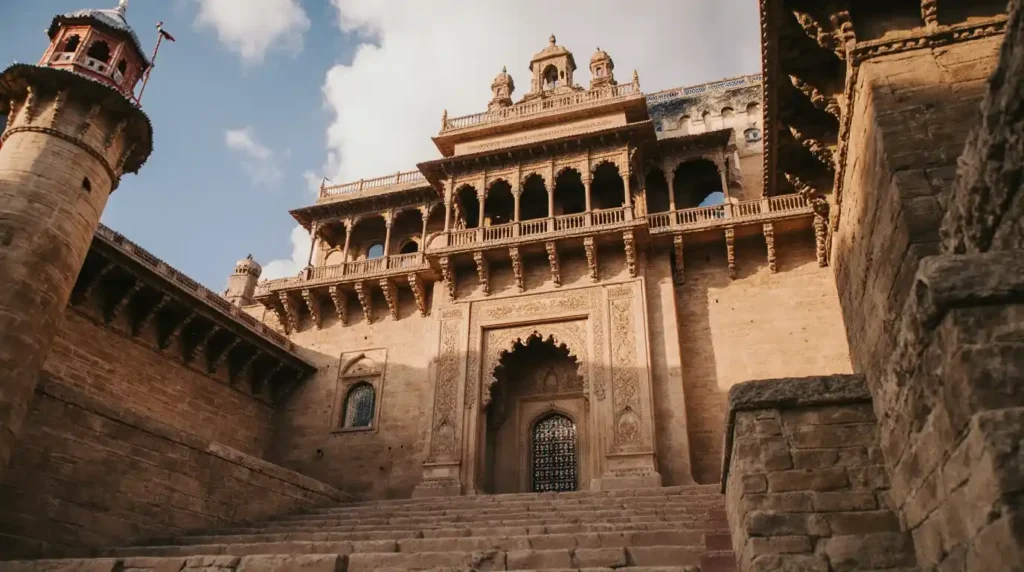
Ramnagar Fort, located on the eastern bank of the Ganges River, is a magnificent example of 18th-century architecture. Maharaja Balwant Singh built this fort in 1750 using sandstone, blending Mughal and Hindu architectural styles.
A Strategic Location
The fort’s strategic location provides breathtaking views of the holy river and the ancient city of Banaras Places. Its thick walls and elevated position made it an ideal defensive stronghold during historical battles.
Exploring the Fort
Inside the fort, you’ll find the Vyasa Temple, dedicated to the sage who authored the Mahabharata. The fort also features a one-of-a-kind museum showcasing:
- Royal artifacts
- Vintage cars
- Medieval costumes
- Ancient weapons
- Astronomical clocks
- Ivory works
The Durbar Hall within the fort displays intricate mirror work and crystal chandeliers. The Maharaja of Banaras Places still resides in the fort, preserving its royal heritage while inviting visitors to discover its historical importance.
Discovering Rare Manuscripts
The fort’s museum, known as Saraswati Bhawan, houses rare manuscripts, including an original copy of the Ramayana written by Tulsidas.
8. Sarnath

Sarnath, located 10 kilometers northeast of Varanasi, is an important Buddhist pilgrimage site. It is here that Gautama Buddha gave his first sermon after achieving enlightenment. This historic place is where Buddhism began as a religious movement, with Buddha teaching the Four Noble Truths and laying down the principles of Buddhist dharma.
Must-See Attractions in Sarnath
1. Dhamek Stupa
The Dhamek Stupa is the most prominent structure in Sarnath, standing at a height of 43.6 meters. It was built in 500 CE and has a cylindrical shape. The stupa features intricate geometric patterns, delicate floral carvings, eight niches designed for Buddha statues, and a solid stone base with a diameter of 28 meters.
2. Ashoka Pillar
The Ashoka Pillar, erected by Emperor Ashoka in 250 BCE, symbolizes India’s national emblem. The original pillar’s capital showcases four majestic lions facing back-to-back and a circular abacus adorned with sculptures of an elephant, galloping horse, bull, and lion.
3. Archaeological Museum
The Archaeological Museum at Sarnath is home to valuable artifacts such as the original lion capital of Ashoka Pillar, ancient Buddhist sculptures, relics from the Mauryan period that have been excavated, and stone inscriptions dating back to the Gupta era.
4. Mulagandha Kuti Vihar
Visitors can explore the Mulagandha Kuti Vihar, a contemporary temple embellished with stunning frescoes portraying Buddha’s life. Within the temple grounds lies a Bodhi tree sapling that originated from the very tree under which Buddha attained enlightenment.
5. Chaukhandi Stupa
The Chaukhandi Stupa marks the location where Buddha first encountered his five disciples. This terraced temple features an octagonal tower added during the Mughal era, resulting in a distinctive fusion of Buddhist and Islamic architectural styles.
A Spiritual Haven for Pilgrims
Sarnath holds deep spiritual significance for Buddhist pilgrims worldwide. They flock to this sacred site, especially during Buddha Purnima, when vibrant prayer ceremonies and meditation sessions fill the atmosphere with reverence and tranquility.
9. Bharat Kala Bhavan Museum
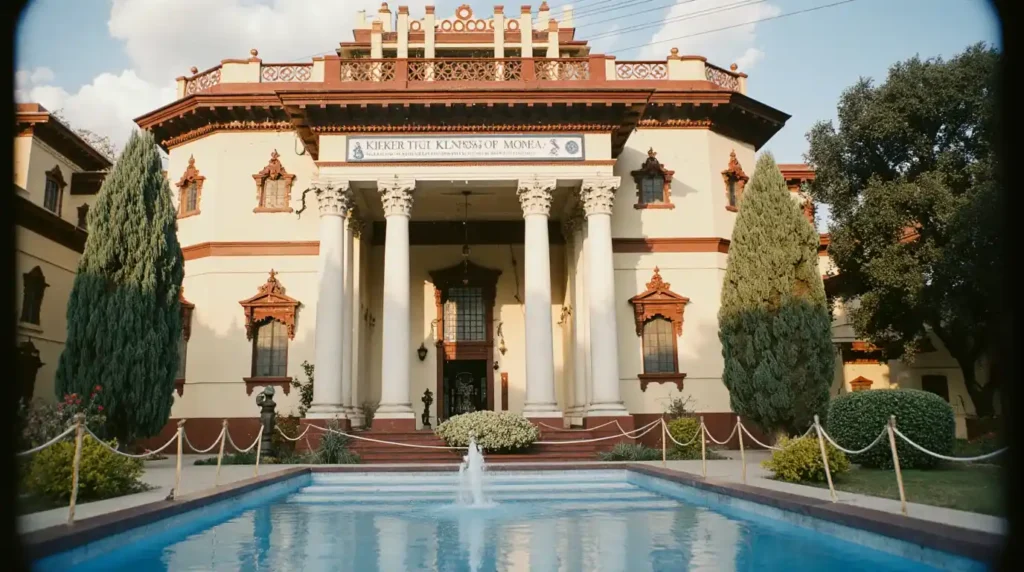
Located within the esteemed Banaras Places Hindu University campus, Bharat Kala Bhavan Museum is a hidden gem of Indian art and culture. This museum boasts an extensive collection of over 100,000 artifacts that tell the story of India’s vibrant history.
Main Galleries
The museum’s main sections exhibit:
- Ancient Sculptures: Rare stone and bronze sculptures from the Mauryan to the Mughal period
- Miniature Paintings: Exquisite works from various Indian schools such as Mughal, Rajasthani, and Pahari
- Archaeological Finds: Terracotta objects, coins, and pottery from different historical eras
- Decorative Arts: Traditional textiles, jewelry, and metalwork showcasing intricate craftsmanship
Nicholas Roerich Gallery and Mahamana Malviya Gallery
The Nicholas Roerich Gallery features paintings by the renowned Russian artist who captured the essence of Indian spirituality and Himalayan landscapes. The Mahamana Malviya Gallery preserves personal belongings and memorabilia of BHU’s founder, Pandit Madan Mohan Malaviya.
Notable Artifacts
Amongst its treasures are:
The rare ‘Seated Buddha’ sculpture from the Gupta period Ancient manuscripts written on palm leaves The famous Chola bronzes collection Original paintings by celebrated Indian artists like Nandalal Bose
Architectural Design and Exhibition Layout
The museum’s architecture showcases traditional Indian design elements, with spacious halls and natural lighting that enhance the viewing experience. Each gallery is arranged chronologically, allowing visitors to trace the evolution of Indian art through various historical periods.
Special Exhibitions and Research Center
Regular special exhibitions highlight specific aspects of Indian culture, ranging from classical dance forms to traditional musical instruments. Additionally, the museum houses a research center where scholars study and document these historical treasures.
Bharat Kala Bhavan Museum stands as a testament to India’s artistic accomplishments, preserving centuries of cultural heritage in one place. Its location within BHU makes it an integral part of the academic environment, nurturing appreciation for Indian art among students and visitors alike.
10. Nepali Temple

The Nepali Temple in Banaras Places is a stunning example of architecture that showcases the strong cultural connection between India and Nepal. Built in the 19th century, this temple is designed to resemble the famous Pashupatinath Temple in Kathmandu, bringing a piece of Nepalese architecture to this sacred city.
Exceptional Woodwork by Skilled Artisans
The most impressive aspect of the temple is its intricate woodwork, created by highly skilled craftsmen from Nepal. These artisans are renowned for their unique craftsmanship and arts, which are reflected in the temple’s structure. Here are some key features of the temple’s design:
- Wooden panels with detailed carvings depicting mythological stories
- A multi-tiered roof styled like a pagoda, topped with golden finials
- Doorways embellished with traditional Nepalese designs
- Window frames showcasing sacred symbols
Unique Nepali Pagoda Style Architecture
The architectural style of the temple reflects the distinct Nepali Pagoda style, which is characterized by:
- Roofs that slope downwards with upturned corners
- Bell-shaped stupas
- Brass work done in traditional methods
- Foundations made of intricately carved stone
Cultural Fusion and Religious Harmony
The blending of artistic elements from both countries can be seen in the design of the temple. Throughout its structure, sacred symbols representing Hinduism and Buddhism can be found, illustrating the peaceful coexistence of these ancient civilizations.
Spiritual Significance and Authenticity
Situated near Lalita Ghat, the temple holds great spiritual importance and attracts both worshippers and architecture lovers. The materials used for construction – mainly wood and stone – were brought over from Nepal, ensuring that the building remains true to its original design. The skillful craftsmanship evident in every part of the temple serves as a living testament to Nepalese architectural brilliance.
Festivals in Banaras Places
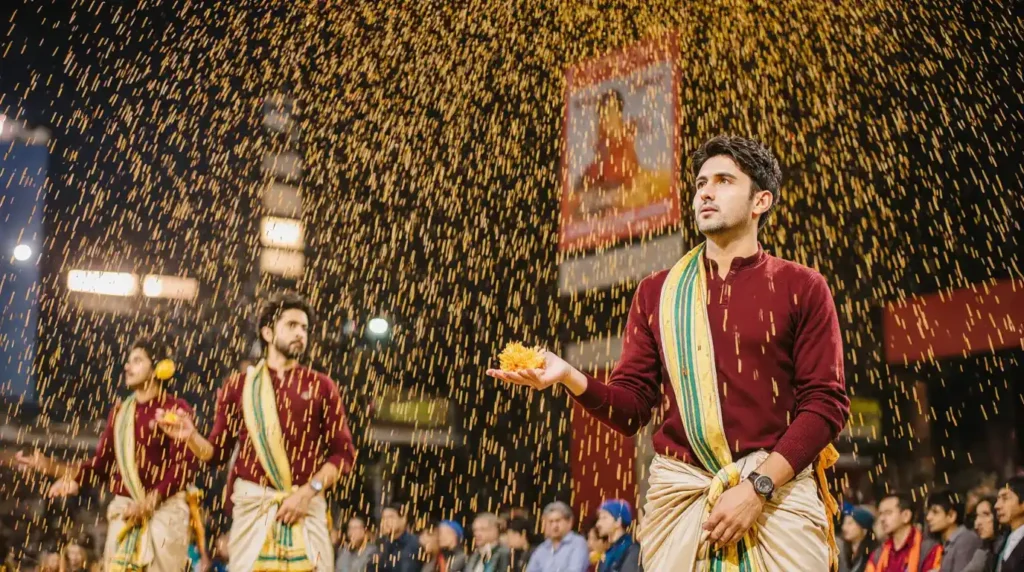
Banaras transforms into a magical realm during its vibrant festivals, with Dev Deepavali standing as the crown jewel of celebrations. Known as the “Festival of Lights of the Gods,” this sacred event falls on Kartik Purnima, marking the moment when gods descend to Earth to bathe in the holy Ganges.
Dev Deepavali: The Festival of Lights of the Gods
The spectacle unfolds across the 88 ghats:
- Over a million earthen lamps illuminate the riverfront
- Intricate rangoli designs adorn the steps
- Sanskrit hymns echo through the ancient stones
- Priests perform synchronized Ganga Aarti at multiple ghats
The divine celebration carries deep symbolism – each lamp represents the soul’s journey from darkness to light. Pilgrims and visitors witness the ghats draped in marigold flowers, while the reflection of countless diyas in the Ganges creates an ethereal mirror of stars.
Ganga Mahotsav: A Celebration of Banaras Places Living Heritage
Ganga Mahotsav brings another dimension of cultural richness to the city. This week-long festival celebrates the living heritage of Banaras Places through:
- Classical music concerts featuring renowned artists
- Traditional dance performances
- Folk art exhibitions
- Boat races on the Ganges
- Crafts bazaars showcasing local artisans
The festival grounds at Rajghat become a cultural nucleus where:
- Kathak dancers spin tales through movement
- Thumri singers fill the air with melodious notes
- Local craftsmen demonstrate centuries-old techniques
- Food stalls serve authentic Banaras Places cuisine
The boat races add a competitive spirit to the festivities, with local boatmen showcasing their skills in traditional wooden vessels. At night, illuminated boats carry musicians along the river, their songs merging with the gentle flow of the Ganges.
These festivals preserve and celebrate Banaras’s cultural identity. The city’s spiritual energy peaks during these times, drawing people from across the globe to participate in age-old traditions that continue to thrive in modern times.
The celebrations extend beyond religious boundaries, creating a space where art, spirituality, and community converge. Each year, these festivals grow in scale and grandeur, yet maintain their authentic cultural essence that makes
Education and Music in Banaras Places
Banaras Hindu University (BHU) is a shining example of India’s dedication to well-rounded education. Established in 1916 by Pandit Madan Mohan Malaviya, this esteemed institution has influenced countless scholars in various fields:
- Arts and Humanities: Home to renowned departments of Sanskrit, Philosophy, and Ancient Indian History
- Scientific Research: Pioneering work in fields like Physics, Chemistry, and Engineering
- Medical Sciences: The Institute of Medical Sciences serves as a major healthcare hub
- Spiritual Studies: Unique programs combining traditional wisdom with modern academic approaches
The university’s expansive 1,300-acre campus is filled with research centers, libraries, and museums, creating a lively environment for academic achievement and cultural preservation.
The Musical Heritage of Banaras Places
The city’s musical heritage, embodied in the Benares gharana, represents a distinctive school of Hindustani classical music. This gharana has produced legendary musicians who have enriched India’s cultural landscape through:
- Rich taan patterns
- Complex layakari (rhythmic variations)
- Extensive use of bol-baant
- Emphasis on emotional expression
Notable musicians from this tradition include:
- Pandit Ravi Shankar
- Girija Devi
- Bismillah Khan
Thriving Musical Tradition
The musical tradition thrives through:
- Regular concerts at BHU’s Faculty of Performing Arts
- Traditional guru-shishya parampara
- Music festivals throughout the year
- Collaborative performances with international artists
BHU’s Department of Musicology actively documents and preserves these musical traditions while nurturing new talent. Students receive training in both theoretical aspects and practical performance, ensuring the continuation of Banaras’s rich musical legacy.
The combination of education and music in Banaras Places creates a special cultural atmosphere where ancient knowledge meets modern learning. This makes it an ideal place for those seeking knowledge and artistic excellence.
FAQs (Frequently Asked Questions)
What is the historical and religious significance of Banaras Places (Varanasi) as a holy city?
Banaras, also known as Varanasi or Kashi, is one of the oldest inhabited cities in the world and holds immense religious significance as a major Hindu pilgrimage site. It is closely associated with Lord Shiva and considered a sacred place for spiritual activities along the Ganges River.
What makes the Kashi Vishwanath Temple a prominent pilgrimage site in Banaras?
The Kashi Vishwanath Temple is revered as one of the most important Hindu temples dedicated to Lord Shiva. It boasts remarkable architectural beauty and unique features, attracting millions of devotees who come to seek blessings and experience its spiritual ambiance.
What is the importance of Dashashwamedh Ghat in Banaras’ cultural and spiritual life?
Dashashwamedh Ghat serves as a bustling hub of spiritual activities and rituals in Banaras. It is especially famous for the mesmerizing Ganga Aarti ceremony held every evening, where devotees gather to witness the devotional worship performed on the banks of the sacred Ganges River.
Can you explain the significance of Manikarnika Ghat in Hindu death rituals?
Manikarnika Ghat is one of Banaras’ cremation ghats and holds profound religious importance as it is believed to be the gateway to Moksha (salvation) for Hindus. The rituals performed here symbolize liberation from the cycle of birth and death.
What are some key attractions within Banaras Hindu University (BHU)?
Within BHU, visitors can explore the New Vishwanath Temple, an architectural marvel dedicated to Lord Shiva. Additionally, Bharat Kala Bhavan Museum houses diverse collections including ancient sculptures, paintings, textiles, and manuscripts that reflect India’s rich cultural heritage.
What festivals are uniquely celebrated in Banaras that highlight its cultural heritage?
Banaras celebrates Dev Deepavali with great fervor, where thousands of oil lamps light up the ghats symbolizing victory over darkness. The city also hosts Ganga Mahotsav, a week-long festival featuring music, dance performances, and boat races on the river, showcasing its vibrant cultural traditions.



